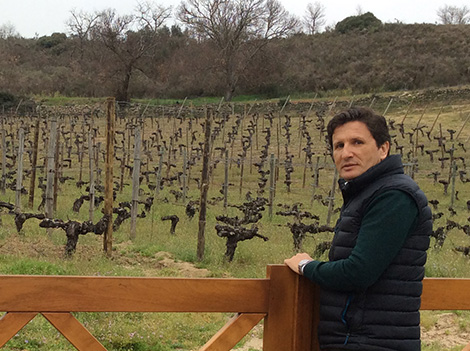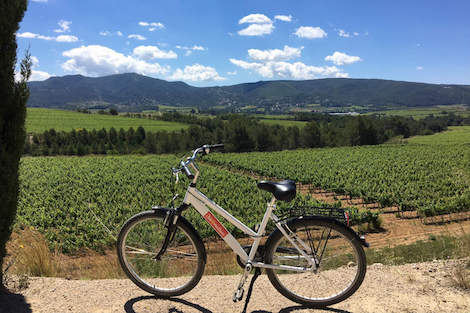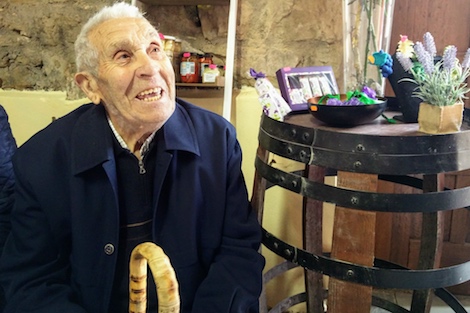
In years to come, Rafael Palacios, aka Rafa, is likely to think of 2017 as his toughest year after frosts devastated many of his vineyards in April. The scars are still visible: aggressive pruning, lost graftings and plants that had to be uprooted. After reaching record levels in the 2016 vintage with 300,000 bottles, production is unlikely to exceed 130,000 bottles in 2017.
Valdeorras, the region where Palacios has set higher quality (and price) standards for Godello whites, is becoming increasingly attractive for outside investors. “I can feel the pressure”, Rafael admits as we walk out of his winery in A Rúa in the Sil valley. We head towards the Bibei valley, the most rugged and untamed area in the appellation where he grows most of his vines. After his very own annus horribilis, Palacios decided to stop producing the entry-level Bolo to be less dependent on third-party grapes.
Passionate for whites
Things were rather different when Palacios moved to Valdeorras in the early 2000s to work with Valdesil, a classic producer in the area based in the Sil valley.
After gaining experience in France and Australia, Rafael Palacios saw himself as "a white specialist". In the 1997 vintage he had helped to launch Plácet at the family winery in Alfaro (Rioja Baja), but Galicia acted as a magnet for him like no other place before. "I became a grape grower in Valdeorras," he acknowledges. “All of a sudden, I realized how strong my ties to this land were. Perhaps that is why I’m not really interested in working in other white producing areas”, he muses.
Hasn’t he ever been tempted to make reds? Or perhaps there is a family pact with his famous older brother to stay away from each other’s spaces? Álvaro Palacios, who now owns the family winery in Rioja, is better known for his outstanding Priorat and Bierzo reds. Significantly, the only white in his portfolio is Plácet. Rafael, for his part, usually grafts the red vines in his vineyards with Godello, despite shining examples of first-class reds made next door by Telmo Rodríguez and Pablo Eguzkiza, his most notable neighbours in the Bibei valley.
Altitude and quality go hand in hand
Palacios grows 33Ha, of which 21.5 are his own and the rest are rented. He also buys grapes from five growers in the area, yet the idea is to directly oversee every grape entering the winery. As he works to become organic and is set to request the biodynamic seal for the plots behind his single-vineyard wines, he acknowledges the difficulties of getting his suppliers certified.
Many of the vines he planted when he settled in the area are now 10 to 15 years old. He used them for Bolo but they are now destined to Louro, a blend of Godello with 8% Treixadura that Rafa describes as “commercial”, even though it is conscientiously fermented an aged in foudres. Grapes are sourced from vineyards at 580 to 640m above sea level, most of them in the village of O Bolo. Sandy soils with some clay are dominant.
"As elevation increases, clay gives way to pure sand,” explains Palacios as we get to the Bibei valley. "This is an area of pure granitic soils," he stresses. Compared to the wide spaces of the Sil valley, the landscape here is much steeper and rugged. Ribeira Sacra lies on the opposite side of the river.
Although sun and high temperatures were forecast, the morning starts grey and cloudy. "It's very common here,” explains Palacios. “We usually have early morning mists; in fact, cold nights are a key quality factor in the area.” The greatest risk is frost, which may occur until the first week of May.
Sand, granite, northern exposure
80% of As Sortes, his flagship white wine, comes from vineyards grown in Santa Cruz, one of the hamlets of O Bolo. According to Palacios, "As Sortes encompasses the landscape of the Bibei valley, capable of transforming the expression of Godello thanks to three key elements: high elevation, sandy-granite soils and a northern exposure. For him, Bibei helps him to “keep well away from those fat, heavy Godello whites".
As Sortes was named after the local tradition of drawing lots known as “sorte” (Galician for chance) to split the inheritance. Plots can be ridiculously small as land is split over and over throughout the years. Land belonging to different owners can be easily identified just by looking at their farming habits (particularly if herbicides are used) or by the contrast between abandoned and tended vines.
As Sortes is a blend of six different vineyards that are mostly fermented with indigenous yeasts in 500-litre oak barrels, each of which has its own water-cooling system.
During my visit on the last week of April, there was a lot of ploughing activity on the vineyards after the abundant rainfall of previous months. Vineyard tasks are planned conscientiously. The most relaxed time of the year —between harvest and pruning— is destined to new plantings and to the very laborious task of building terraces and restoring stone walls.
“Stone terraces are amazing and I’m a staunch defender of them; they are an essential element in the region’s wine heritage,” explains Rafa, who praises their capacity to retain organic matter in an area of high erosion and steep slopes. "The problem is that heat accumulation can affect the vines; that’s why we leave a bit of room so that the plants are not too close to the walls."
The new Sorte Antiga and other single-vineyard whites
Rafa Palacios is a meticulous producer. Not only his winery is kept in pristine condition, but his painstaking attention to detail is particularly evident in his vineyards and surrounding areas. Palacios even asked permission from a local farmer to cover part of his unsightly property with a tarpaulin. Many of Rafa’s vineyards are protected to keep wild boars away whereas his most prized ones feature low walls and gates following the traditional Burgundian style.
Sorte O Soro is his first single-vineyard wine and his most treasured. First released in the 2011 harvest, there was a previous trial in 2009 that was never sold but which is at its peak now. Production does not exceed 3,000 bottles and it is now priced at €120 in Spain —sadly out of reach for most wine lovers. This plot was one of the first Godello plantings after this variety was recovered in the late 1980s. It was built on existing terraces by Paco Blanco, a grower from whom Palacios bought several vineyards. Sorte O Soro seems to have ideal conditions: a balanced Godello clone, perfect density and distribution of vines, oxidized granite soils with extremely fine sand that confer a briny character to the wine and permanently exposed to the cooling breeze.
With its “extreme acidity”, Sorte Souto has traditionally been more complicated to farm. Made as a dry wine a couple of times, Palacios thinks that its true nature is sweet, so a late-harvest Godello has been occasionally released without much fanfare. It’s not made every year and Palacios thinks this is his most elusive wine so far.
Sorte Antiga is the oldest plot planted in the 1920s. It covers barely 0,23Ha with vines directly emerging from the rock (“granite is particularly hard here”, says Rafael). Soil and roots are so shallow that it cannot be ploughed, so a hoe is used once a year. The rest of the time is covered with straw to "avoid water evaporation and to prevent sun rays from penetrating the ground and encouraging weed growth", Palacios explains. He has devised an inverted pyramid-shaped trellising system to hold the tendrils and protect them from the wind. Later in the summer, this system shades the bunches.
“Antiga has never shown the finesse of O Soro, but the grape skins of a hundred-year-old vineyard has enormous potential,” Palacios explains. That’s why he has used a very traditional approach to bring out such potential. It is such a delicate orange wine that no one would guess on the first sniff that skin were in contact with the wine for one month. The fine tannins on the palate offer a clue but this wine is far form your average skin-contact wine. A vibrant, citrus acidity lifts this magical, vertical wine —the first vintage, 2016, is due to be released by the end of 2018. The process he has followed to make this wine is secretive, in tune with the tiny vineyard to which Rafael Palacios has devoted so much time and attention.
After almost 15 years working in the Bibei valley, Palacios says: "I am not a producer who gets involved in new things every other minute".

Amaya Cervera
A wine journalist with almost 30 years' experience, she is the founder of the award-winning Spanish Wine Lover website. In 2023, she won the National Gastronomy Award for Gastronomic Communication
NEWSLETTER
Join our community of Spanish wine lovers






